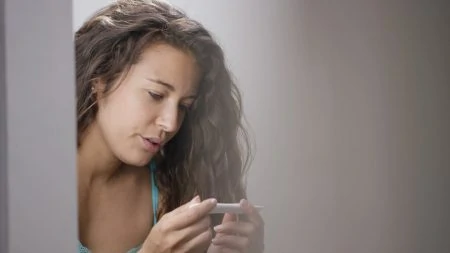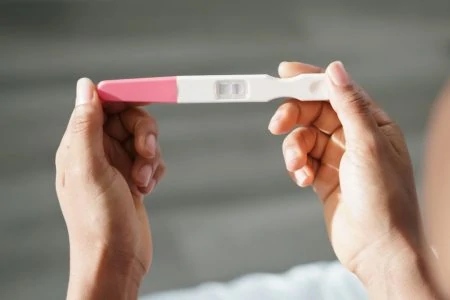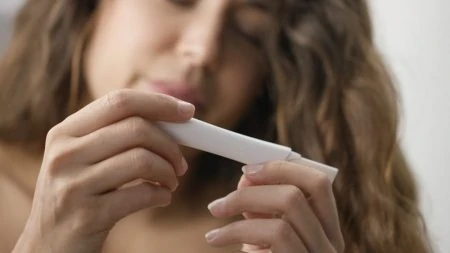Do you suspect you may have blocked fallopian tubes and are wondering what your options are?
In my practice, I’m constantly reminded that every woman is different when it comes to conception. It seems like some women only need to look at sperm and they’re pregnant, while others try for months or even years.
If you’re in the latter category, blocked fallopian tubes are a possibility.
In this article, our medical team will discuss the symptoms of blocked fallopian tubes, the causes, how they are diagnosed, and your odds of getting pregnant when you have this condition.
Key Takeaways
- Blocked fallopian tubes can cause infertility and increase the risk of ectopic pregnancy.
- Common causes of blocked tubes include pelvic inflammatory disease, endometriosis, fibroids, and sexually transmitted diseases.
- Diagnosis of blocked tubes may involve a hysterosalpingogram (HSG), ultrasound, or laparoscopy.
- Treatment options include surgery to unblock tubes, in vitro fertilization (IVF), or considering alternatives like adoption or fostering.
What Are Blocked Fallopian Tubes?
Fallopian tubes are narrow tubes on either side of your uterus. They connect your uterus to your ovaries.
Every month when your ovaries release an egg, it passes down the fallopian tubes. If there is an obstruction, the egg cannot pass through to the uterus.
Likewise, sperm cannot swim up the tubes to fertilize an egg. Conception usually occurs in the fallopian tubes. The fertilized egg then travels to the uterus, where it embeds itself and grows.
Partial or fully blocked tubes can lead to infertility. If the blockage is partial, there is an increased risk of an ectopic pregnancy, where the fertilized egg grows in the fallopian tube instead of the uterus.
About 30% of women infertile women will be diagnosed with blocked fallopian tubes or tubal blockage. Of these women, 19% will try for a first baby for over a year without success (primary infertility). Another 29% will have had one successful pregnancy but fail to become pregnant a second time (secondary infertility) (1).
Symptoms of Blocked Fallopian Tubes
You might not have any indication that your fallopian tubes are blocked until you can’t get pregnant. Months of trying to get pregnant and not succeeding are disheartening and upsetting. It’ll leave you wondering if there’s something wrong.
You’ll likely share your concerns with your health care provider. If you’re under 35 and have been trying for a baby for a year, investigations will be carried out to see if there is a reason for your infertility. If you are over 35 years old, this might be done after just six months of trying.
Checking your fallopian tubes will form part of these fertility tests. One kind of blockage, called a “hydrosalpinx,” might give symptoms. This is a build-up of fluid in one or both fallopian tubes, which makes them larger. The sperm and egg can’t pass through the fluid, so conception cannot occur.
Symptoms include pain in the lower abdomen, which might be worse around the time of your period. You may also have abnormal vaginal discharge (2).
Other conditions, like endometriosis or pelvic inflammatory disease, can also mean painful periods. While these conditions can make matters worse, they don’t always cause blockages directly.
Causes of Blocked Fallopian Tubes
Scar tissue or pelvic adhesions are usually the causes of fallopian tube blockages. There are several reasons this can happen:
- Pelvic inflammatory disease: This causes inflammation in the lower genital tract, which then spreads upwards to the cervix, uterus, fallopian tubes, and ovaries. In 85% of cases, this disease is the result of sexually transmitted bacteria (3).
- Endometriosis: The endometrial tissue lining the inside of the uterus can sometimes grow outside the womb or in the fallopian tubes. When this happens, it can cause a blockage. Up to 60% of women who experience painful periods have endometriosis, accounting for up to 30% of all infertility causes (4).
- Fibroids: These non-cancerous growths affect the muscular tissue of the uterus and can grow to be 7 inches or more. If they are near the fallopian tubes, they can block them and cause infertility (5).
- Sexually transmitted diseases: Some infections women contract during sexual contact can lead to scarring on the ovaries. These include gonorrhea, chlamydia, trich, and mycoplasma. The scarring is likely to be worse if these diseases are left untreated (6).
- Previous ectopic pregnancy: A pregnancy that has happened in the fallopian tube can leave scarring or damage to the fallopian tube involved (7).
- Abdominal surgery: Previous surgery in the pelvic area may leave scarring and adhesions, which can lead to blockage of the fallopian tubes, causing infertility (8).
Some of these causes cannot be prevented. Nevertheless, practicing safe sex and getting early treatment can help stop blocked fallopian tubes as a result of sexually transmitted infections.
One thing you can do to help detect problems is to have regular check-ups with your gynecologic provider. If you have any concerns about pain or discharge, your provider may recommend a pelvic exam to determine the cause.
How Are Blocked Tubes Diagnosed?
A “hysterosalpingogram,” or HSG, is a special X-ray that can show if tubes are blocked. This procedure doesn’t take long, only about five minutes.
Your doctor will insert a small tube into your cervix, then slowly fill your uterus with a dye containing iodine. You can see this dye on an X-ray. The path it takes will highlight whether there is a blockage in the tubes.
If a tube is blocked, the dye won’t be able to pass. If not, the dye will pass through the ovaries into the pelvis, and the body will absorb it (9).
The HSG is a basic test carried out when fertility is in question. It’s worth noting that 15% of women might have a false negative test, and about 17% may receive a false positive result. For these reasons, doctors might repeat the test or recommend other tests (10).
The HSG may be painful for some women. I’ve heard women say it was completely painless and others complain that it is excruciating. Speak to your doctor to see if you should take over-the-counter pain medication before the procedure.
Editor's Note:
Caitlin Goodwin, MSN, RN, CNMThese are some of the other tests:
- Ultrasound: For the fallopian tubes to show up on an ultrasound scan, fluid must be present. A saline solution will be introduced to the uterus via a tube for this treatment. The passage of the saline is monitored to see if there is a blockage (11).
- Laparoscopy or hysteroscopy: This surgical procedure involves a small camera on the end of a thin tube being placed into your uterus or abdomen. Carried out under a general anesthetic, it can detect abnormalities such as endometriosis, fibroids, or adhesions (12).
Treatments for Blocked Fallopian Tubes
Treatments can be carried out to try to open your fallopian tubes. However, these are not without risks, and your doctor will discuss these with you. There’s a chance they could be unsuccessful, or the tubes can re-block.
Another option is to bypass your fallopian tubes entirely and attempt IVF treatment. We will cover IVF more in a moment, but first, let’s look at the options for treatment for blocked tubes.
- Tubal cannulation: During this procedure, a catheter is placed into the uterus, guided by wire, and is moved into the fallopian tube to clear the blockage (13).
- Laparoscopic surgery: If a blockage is found during a laparoscopy test, the cause can sometimes be removed using the camera and special surgical instruments. This will often be done at the same time as the exploratory laparoscopy, possibly negating the need for further surgery (14).
- Fimbrioplasty: Doctors might recommend this procedure if the blockage is close to your ovaries. It clears the blockage and rebuilds the fimbriae, the small finger-like projections that move your eggs once released (15).
The success of these treatments can depend on several factors, including age, where the blockage is, how bad it is, and the reason behind it.
There’s also an increased risk of ectopic pregnancy following tubal surgery. For this reason, if you become pregnant, you should be monitored closely by your health care provider.
Laparoscopic treatment for endometriosis can result in about a 40% chance of natural conception (16).
If you have minimal scarring and the tubes are otherwise healthy, the chances of getting pregnant are good after they are opened. This is also the case if you have only one blocked tube (17).
There are occasions when surgery may not be a viable option. If you have a lot of scarring or many adhesions in your tubes, or you have hydrosalpinx, then surgery is not likely to be a success. You might be better off considering IVF.
These are some other considerations when thinking about surgery to unblock fallopian tubes (18):
- Male infertility: When it comes to getting pregnant, it takes two to tango! If your partner has infertility issues as well, then IVF — possibly with donor sperm — could be an option.
- Maternal age: IVF could also be considered a more favorable option for women over the age of 35 years.
- Issues with ovulation: If your ovaries are not working effectively, IVF might be a good option for you.
In Vitro Fertilization (IVF) for Pregnancy
There was a time when surgery was the only option if a woman had blocked tubes. It was then a question of praying that it worked. The invention of IVF now gives couples another option for conception and pregnancy.
This treatment starts with you taking medications to improve your fertility by stimulating your ovaries to produce eggs. The eggs are then removed from the ovaries by a doctor using an ultrasound and a long thin tube inserted from your vagina.
The eggs are introduced to sperm from your partner in a special container in a laboratory. If your partner has fertility issues, then donor sperm can be used.
The eggs and sperm are closely monitored, and if all is well, in about three to five days, some healthy embryos will result. One or more embryos are then placed directly into your uterus using a thin tube inserted through your cervix.
Hopefully, one or more embryos will then attach to the lining of your uterus and you’ll become pregnant (19).
Before IVF, your doctor may recommend removing or draining your fallopian tubes. It appears that hydrosalpinx can affect IVF negatively (20).
I Had My Tubes Tied. Can This Be Reversed?
Some women choose to have their fallopian tubes “tied” as a method of contraception. Sometimes, they regret this decision later in life.
The good news is that this voluntary surgery that blocks your fallopian tubes, called tubal ligation, can sometimes be reversed (21).
When the reversal is done microsurgically, the success rate of pregnancy is between 40% and 70% (22). IVF is still an option if you chose this method of birth control earlier in your life.
The decision to have a tubal ligation reversal as opposed to IVF can be a difficult one. There are factors you need to consider. If you are young and plan on having more than one child, then reversal might be a good option. However, if you are over 35 years old, IVF could be a better choice.
The cost of either procedure can vary from state to state. IVF will generally be more expensive, so this might factor into your decision. Be sure you explore your options and are guided by a professional in the field when deciding what to do.
FAQs
Summing It All Up
The chances of becoming pregnant naturally when you have blocked fallopian tubes can vary, depending on the cause and severity of the blockage.
If you have just one blocked tube, and the other is healthy, you could get pregnant without intervention. Surgical options are available for those with two blocked tubes, but this is not successful, or possible, in some cases. In vitro fertilization remains an option for many women.
It can be hard to accept that you might not be able to conceive, but adoption or fostering are good alternatives to consider. Discuss all your options with your doctor and make sure you receive emotional support throughout the process if you need it.













